Part 50: Appendix B2 - Buildings - 2 of 3
Appendix B2 - Buildings Part 2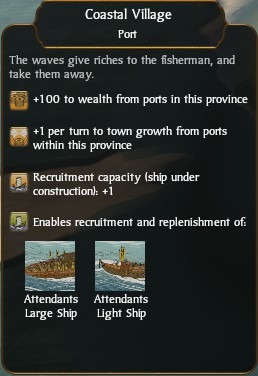
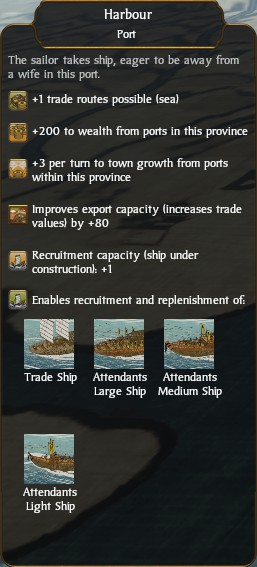
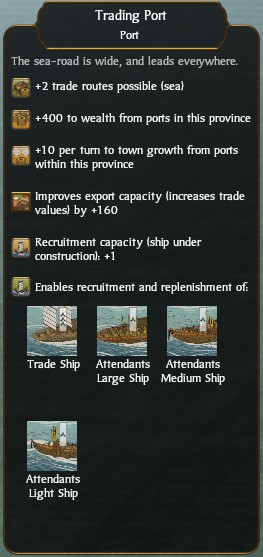
Cost: Free/900/2530
Turns until profit:
code:
Province Tax Rate: 20% 25% 30% 35% 40% 45% 50% 55% 60%
Harbour (900) 34 28 25 22 19 18 16 15 14
Trading Port (2530) 38 33 29 26 23 21 19 18 17Ingame encyclopaedia - Coastal Village posted:
Farmland is precious and relatively scarce in Japan. Any and every other source of food has to be exploited to the full, and the seas provide a rich bounty for those brave enough to go and get it. A coastal village is also a good foundation for all sea-related activities as they are often placed on natural harbours or in sheltered inlets. They provide work and income in a province and can be expanded later. Fishermen and farmers were not quite at the bottom of the social structure in medieval Japan. They were vital if everyone, even the mightiest lord, was going to eat, and had status as a result. They were, however, tied by a hereditary principle that linked social status and employment. Jobs were passed from father to son, and there was little chance of "bettering yourself". Europe had sumptuary laws that limited what people could wear according to social position, but the Japanese discouraged rising above one's station in life by copying any aspect of a higher social class. It was equally unthinkable for higher status individuals to get their hands dirty with manual labour, such as fishing.
Ingame encyclopaedia - Harbour posted:
Building a harbour, or improving on what nature has already given, provides basic warship building capabilities. The harbour can also handle more maritime trade, encouraging the local economy. Surprisingly for an island nation with such a long coastline, the Japanese never developed into a maritime power. Sea battles never really evolved beyond boarding actions, but this did give Japan an advantage when it came to piracy. Booty and loot are no use at all at the bottom of the sea. Japan developed both a pirate tradition and a pirate problem. Japanese pirates were the bane of Chinese coastal shipping for centuries, something that bothered the central and provincial governments not one jot. This provoked severe reprisals from the Chinese from time to time, but without ever solving the piracy issue. There was simply too much money to be made as a pirate. As always happens, some pirates eventually managed to become rich enough that they were seen as respectable. Gold washed away all sins in the end, and remade the pirates as "sea lords".
Ingame encyclopaedia - Trading Port posted:
Although few nobles would ever admit it, trade is vital to a family's success in war and politics. Trade pays for the strength and influence needed for other two activities. A busy port encourages growth in the rest of the province's economy. Despite the wealth that merchants created, they were not well-regarded in medieval Japanese society. Warriors and nobles were, of course, at the top of the social structure. Farmers and fishermen were commoners, entitled to respect for their work, but without power or status. Merchants, however, had a much lower position because they did no useful, honest "proper" work. Their money was very welcome of course, but not the merchants themselves. The money men would eventually have the last laugh, though, when Japan opened up to the modern world.

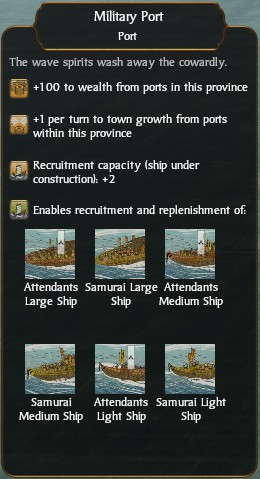

Cost: Free/1020/2700
The Harbour chain focuses increases the number of sea trade routes available as well as wealth growth and wealth bonus to the province. A Coastal Village can either be upgraded into the Harbour chain or the Port chain. The Military Port increases the number of recruitment slots for ships by 1, allowing the construction of two ships at once. It also allows the construction of the Samurai Light, Medium and Heavy ships, as well as increasing the experience of all Attendant ships produced here by 1. A Drydock increases the town wealth of the province as well as adding a further recruitment slot for ships, in addition to allowing the construction of the Firebomb ship. It increases the experience of all ships produced by the Military Port by an additional 2. The Drydock requires access to the Wood trade good.
Ingame encyclopaedia - Coastal Village posted:
Farmland is precious and relatively scarce in Japan. Any and every other source of food has to be exploited to the full, and the seas provide a rich bounty for those brave enough to go and get it. A coastal village is also a good foundation for all sea-related activities as they are often placed on natural harbours or in sheltered inlets. They provide work and income in a province and can be expanded later. Fishermen and farmers were not quite at the bottom of the social structure in medieval Japan. They were vital if everyone, even the mightiest lord, was going to eat, and had status as a result. They were, however, tied by a hereditary principle that linked social status and employment. Jobs were passed from father to son, and there was little chance of "bettering yourself". Europe had sumptuary laws that limited what people could wear according to social position, but the Japanese discouraged rising above one's station in life by copying any aspect of a higher social class. It was equally unthinkable for higher status individuals to get their hands dirty with manual labour, such as fishing.
Ingame encyclopaedia - Military Port posted:
A military port builds and repairs warships, a specialised task that requires specialised yards and specialist craftsmen. Warships must, of course, be built to withstand not only the power of the sea, but everything the enemy can throw at them. Japanese warships were not the same as those of most other medieval navies. Rather than attacking a an enemy ship's structure with large weapons, Japanese ships acted as floating platforms for boarding actions. The crew were the targets of any attacks. The intention in any naval engagement was always to close with the enemy, grapple, and then fight a land battle across the lashed-together ships. This meant that a relatively large crew of soldiers was required, resulting in horrendous casualties in most naval engagements. The losing side simply could not run away from a sea battle; what few prisoners were taken would often be tossed overboard at the end of the battle, or the losers would throw themselves into the sea. This happened at the decisive Battle of Dan-no-ura in 1185, that brought the Gempei War to a close.
Ingame encyclopaedia - Drydock posted:
A drydock is a basin that can be drained for shipbuilding work, and then flooded when a vessel is completed. This allows very large ships to be built safely and then gently floated out when complete. The process of draining and flooding the dock is dependent upon the tides, with lock gates being left open at particularly low tides, and then closed just as the tide turns. This minimises the work to get any remaining water out of the dock. Although slow and cumbersome to operate, a drydock lets shipwrights construct and repair the most powerful vessels invented to date. Historically, it was not until the Sengoku Jidai that the Japanese started building large warships, and even then not for any national fleet. Most Japanese vessels resembled nothing so much as floating castles, probably because of a lack of credible long range anti-ship weaponry such as cannons. Instead, Japanese naval battles nearly always came to be large scale boarding actions, where individual valour and aggression mattered more than seamanship. Unfortunately, this also meant that casualties in naval battles tended to be severe, as ship's crews often had little choice but to fight to the death.
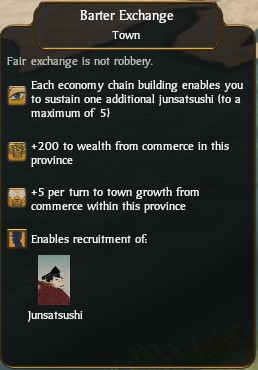
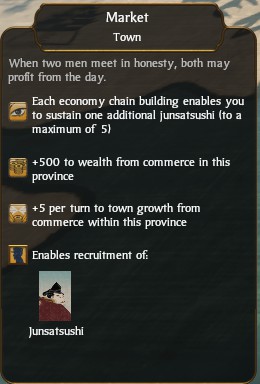
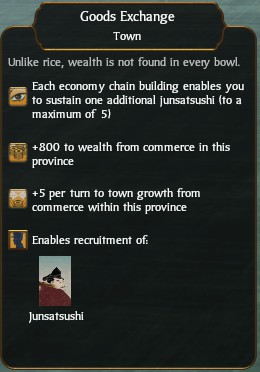
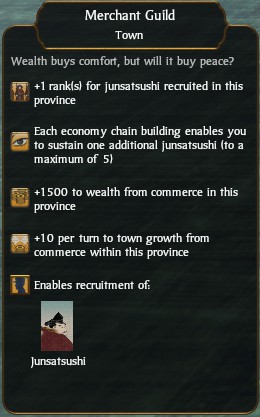
Cost: 800/1800/3300/7600
Turns until profit:
code:
Province Tax Rate: 20% 25% 30% 35% 40% 45% 50% 55% 60%
Barter Exchange (800) 17 14 12 11 9 9 8 7 7
Market (1800) 30 24 20 18 15 14 12 11 10
Goods Exchange (3300) 55 44 37 32 28 25 22 20 19
Merchant Guild (7600) 47 39 33 29 25 23 21 19 18Ingame encyclopaedia - Barter Exchange posted:
A barter exchange allows farmers, fishermen, traders, indeed anyone, to swap goods they produce for other items they need. It improves the wealth of a province because people can specialise and become experts if they can swap their surplus for someone else's surplus. If, for example, a farmer can barter he can spend all his time farming, rather than wasting time trying to be an indifferent weaver. Barter is probably the oldest and most universal form of trade in the world. Anyone can understand the simple idea of swapping one thing, or pile of things, for another. Anyone with a surplus of something can become "richer" by trading that surplus away for other goods: his new possessions are his for less overall effort than if he had made them himself. It is, however, quite difficult to calculate fractional values for goods, or to organise complicated swaps involving more than a couple of goods or traders. Trade in kind is a very simple "spot market", and really rather hard to tax in a practical way. Is a tax of a bag of grain the same as taking a goat, a chicken or a bullock? And where does the taxman keep all these chickens and rice bags he has taxed?
Ingame encyclopaedia - Market posted:
A market adds substantially to a province's taxable wealth. A market has cash in circulation: there are prices, often controlled by the lord, expressed in monetary terms, not in the number of chickens that must be swapped for so many rice sacks. Once people can sell their surplus, they will always seek out goods to buy, and that can add substantially to the economic activity in a province. Despite the need for trade, the activity was considered rather improper in medieval Japan. Merchants, like many townsmen, had a lower status than hardworking peasants. Whatever the merchants were doing to earn a living, it was obviously not quite as honest or straightforward. And, despite the fact that the nobles enjoyed spending the taxes they gathered, they certainly considered trade to be utterly beneath any proper gentleman. Merchants and cash have their uses, though: it is easier to transport wealth around in the form of coin and treasure than as rice sacks!
Ingame encyclopaedia - Goods Exchange posted:
A goods exchange adds significantly to a province's wealth. Merchants, traders and craftsmen can specialise, and buy or produce in bulk making their wares more profitable. It is the ability to specialise and find a market for your works that allows great craftsmen to flourish. A single very rich patron can create his own personal market for craftsmen, of course, but a marketplace with many customers is more profitable and stable in the long run. After all, the death of a lordly patron means the money and trade he created disappears. It takes a significant disaster to wipe out a complete province full of customers! Market forces in the form of the natural aspirations of people to want better, nicer things soon bring wealth.
Ingame encyclopaedia - Merchant Guild posted:
A merchants' guild adds to the amount of wealth in a province. By forming a guild, the merchants gain control of trade with other provinces, and have a cosy cartel that fills their purses at the expense of others. This wealth can then be taxed by its overlords. After all, it is fair that the merchants, with so much to protect, should end up paying a substantial amount for their safety. Guilds were often granted trade concessions in return for knowing their place in the scheme of things, and paying their taxes promptly. While merchants could become extremely rich, socially they were regarded as being lower than humble peasants: they did not labour honestly in the fields to feed people, but somehow made money in unnamed, but undoubtedly unsavoury, ways. It was, of course, completely beneath any warrior to actually work for a living, so merchants and other townsfolk remained an unfortunate necessity.


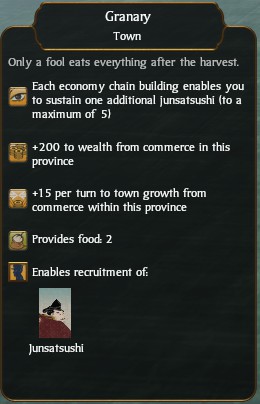

Cost: 800/2000/3000/7500
Turns until profit:
code:
Province Tax Rate: 20% 25% 30% 35% 40% 45% 50% 55% 60%
Barter Exchange (800) 17 14 12 11 9 9 8 7 7
Food Stores (2000) 64 57 52 48 45 43 40 39 37
Granary (3000) 78 70 64 59 55 52 49 47 45
Grain Warehouse (7500) 59 52 46 42 39 36 34 32 30Ingame encyclopaedia - Barter Exchange posted:
A barter exchange allows farmers, fishermen, traders, indeed anyone, to swap goods they produce for other items they need. It improves the wealth of a province because people can specialise and become experts if they can swap their surplus for someone else's surplus. If, for example, a farmer can barter he can spend all his time farming, rather than wasting time trying to be an indifferent weaver. Barter is probably the oldest and most universal form of trade in the world. Anyone can understand the simple idea of swapping one thing, or pile of things, for another. Anyone with a surplus of something can become "richer" by trading that surplus away for other goods: his new possessions are his for less overall effort than if he had made them himself. It is, however, quite difficult to calculate fractional values for goods, or to organise complicated swaps involving more than a couple of goods or traders. Trade in kind is a very simple "spot market", and really rather hard to tax in a practical way. Is a tax of a bag of grain the same as taking a goat, a chicken or a bullock? And where does the taxman keep all these chickens and rice bags he has taxed?
Ingame encyclopaedia - Food Stores posted:
Food stores improve the amount of food available in a province, and the province's growth. No more food is grown, but less of what is produced is lost in storage. In the medieval world, including Japan, the harvest was the vitally important time of year. Only the very brave or the very thoughtless campaigned when there was a harvest to be gathered in. The amount of food gathered and then stored over winter determined exactly how many people would be alive come spring. Even then, poor storage conditions could result in the crop mouldering away in damp conditions. In a good year, everyone in a village would have enough to eat. A bad year, either because of poor weather or, worse still, rapacious bandits or the lord's tax collectors, would mean starvation and death. The elderly and the children would be the first to die, then the weak and sick among the adults. Even the lord in his castle could feel the pinch of hunger in his belly if the crop failed.
Ingame encyclopaedia - Granary posted:
Food storage until the next harvest is very important to the functioning of any community. If no one can think beyond where their next meal might come from, there is no incentive to do very much other than look for that next meal. Once there is a reasonable degree of certainty that people will be able to eat tomorrow, the next day, next week and beyond, they can start planning for a future, and working towards it. It becomes worthwhile to improve your land, build a new workshop, or learn a new skill: you will live long enough to see the benefits of your efforts!
Ingame encyclopaedia - Grain Warehouse posted:
Better food storage means that fewer people starve, and that more survive the lean years when they inevitably come. It is also possible to create enough of a food surplus so that it can be traded, bringing wealth into the province and making people's lives better in that way. Once a community has the spare time and capacity over and above feeding itself, creativity and hard work can bring further rewards, other than just living for a few more hungry years!
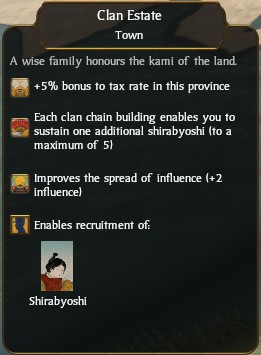
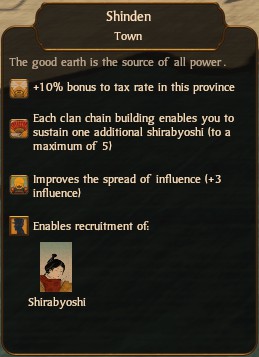

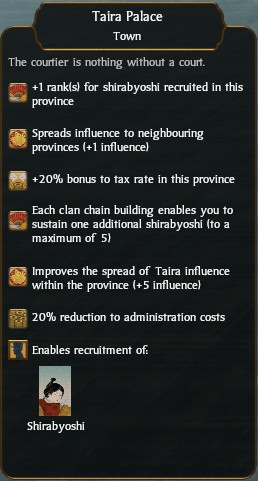
Cost: 700/1520/3600/6800
Turns until profit:
code:
10% Admin/20% Admin/40% Admin
Province Wealth: 1000 1500 2000 2500 3000 3500
Clan Estate (700) 15/18/23 11/12/16 8/9/12 7/7/10 6/6/8 5/5/7
Shinden (1520) 34/38/51 23/26/34 17/19/26 14/16/21 12/13/17 10/11/15
Mandokoro (3600) 80/90/120 54/60/80 40/45/60 32/36/48 27/30/40 23/26/35
Taira Palace* (6800) 152/170/227 101/114/152 76/85/114 61/68/91 51/57/76 44/49/65
Ingame encyclopaedia - Clan Estate posted:
A clan estate improves the collection of taxes within its province. It also provides entertainments for the nobility and gentry, and shirabyoshi are trained there. Almost regardless of time and place in human history, powerful men have made a point of controlling large tracts of land, often depriving farmers of ownership in the process. Before the arrival of industry, and without craftsmen working in large groups, land and wealth were inextricably linked. A lord's landholding defined his status with his peers, his underlings, and at the Imperial Court; enough land and enough wealth could even overcome any doubts or uncertainties about family or personal honour.
Ingame encyclopaedia - Shinden posted:
The shinden improves clan influence and tax rate effects. Primarily concerned with land and financial oversight, this is an organisation that oversees all government business. The day-to-day issues of running people's lives, collecting taxes and making sure that criminals are brought to book are left to lesser departments.
Ingame encyclopaedia - Mandokoro posted:
Law and order are important in any stratified and authoritarian society. Everyone has to know their place in the system, and the penalties for transgression. It is a practical solution to the problem of having many people live in a relatively small space, if not very attractive to those at the bottom of the social heap. In this, Japan was no different to many other parts of the world in the medieval period. "Social mobility" or moving from one social class to another was almost completely unknown. A man would be born, live and die a samurai, peasant or townsman. He could fall into poverty as a samurai and be unable to earn a living because it was socially beneath him, or rise to tremendous riches as a townsman, and remain lower in the social pecking order than the humblest peasant. The law, however, existed to protect those who behaved themselves and stayed within the bounds of acceptability.
Ingame encyclopaedia - Taira Palace posted:
This palace increases Taira family influence immensely. It also improves tax collection, and gradually converts the people of neighbouring provinces into supporters of the Taira, if only because of its overwhelming grandeur. Additionally, shirabyoshi trained in this province are more experienced, simply because they have such a demanding Taira audience to satisfy at the palace. Historically, the Gempei War ended disastrously for the Taira family. Arrogance, understandable perhaps, and excessive ambition eventually brought a reaction from the other great families. The Taira were usually outmatched in battle, even with the person of the Emperor to inspire their warriors. Eventually, most of the Taira drowned at the Battle of Dan-no-ura; those who were aboard ships not sunk by enemy action threw themselves into the sea, along with the six-year-old Emperor Antoku. The Taira also attempted to throw the Imperial regalia into the deeps, and may even have done so with the sword and the mirror, although these may have been ceremonial copies rather than the originals given that the regalia is still in use today. The remaining Taira were executed.
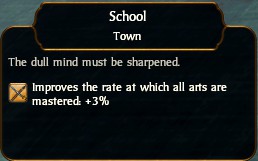
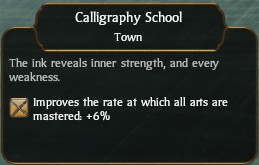
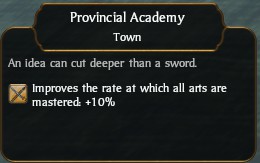

Cost: 765/2070/3360/5600
The School building chain increases the technology rate of your clan for both Budo and Bunka arts. The Calligraphy School further increases the bonus to arts. The Provincial Academy continues to improve the bonus to arts. It requires the Chinese Texts trade good. The Confucian Academy provides an enormous boost to arts, but only a single such building can be constructed in your empire. It also requires the Chinese Texts trade good.
Ingame encyclopaedia - School posted:
A school gives a basic education to those who can learn and have enquiring minds. This helps with research into the arts, as students experiment with their new-found wisdom. An educated class is also the sign of wealth and spare productive capacity in a province. It is only when there is spare time to look up from the daily grind of trying to feed yourself and your family that any kind of organised, formal education becomes possible. And when that tipping point is reached, the world opens up. With education a man is no longer limited only to learning from his experiences, and he can move beyond the accumulated folk wisdom of his fellows. Existing knowledge can be studied, commented upon, and used as a basis for further thought.
Ingame encyclopaedia - Calligraphy School posted:
Written records are important for both for government purposes and for intellectual pursuits. Without books, ideas are lost as men die; an idea written down has more power than any sword. A calligraphy school creates the scribes that are needed to record everything that occurs in a lord's domain. Thinkers need to record their thoughts, and these can then be widely promulgated. Fine calligraphy is one of the arts that Japan has made its own. A written language that is based on ideograms rather than an alphabet almost demands that scribes produce beautiful texts just as artistic achievements. The act of writing became an act of meditation, and the artistic sincerity and beauty of the finished product only added to the meaning of a document. The recipient of a message could easily be swayed by the perfection of the calligraphy, as much as by what the document actually said. It was respectful to the reader, not to mention honourable, for the writer to put his heart and soul into his skilled calligraphy.
Ingame encyclopaedia - Provincial Academy posted:
By gathering the very best scholars together in one place, a provincial academy becomes a power-house for new ideas and for reviewing age-old wisdom. The challenging of older ideas may not always be encouraged, but in such an atmosphere of learning, development of the arts proceeds apace. The ideas of Confucius (551 - 478BC) were hugely influential across Asia, including Japan. Confucius valued education as a way of bettering people and society, and his ideas encouraged a meritocratic approach to education. Those who could learn should learn as far Confucian philosophy was concerned. At the same time, the growth of Japanese Imperial influence required more courtiers and administrators: these men had to be educated to a high standard if they were going to be capable of doing their jobs. A strong man with a good sword arm was not enough to run a province properly.
Ingame encyclopaedia - Confucian Academy posted:
A Confucian academy aims to improve its students by teaching a philosophical system that embraces political, ethical, moral, and even religious elements. The teachings of Confucius give the students a deep understanding of the world, and greatly aid the development of the arts in the process. The Chinese philosopher Confucius (551-478 BC) is one of the most influential figures in world history. Confucian teachings are, at heart, optimistic and humane, holding that men can be taught and made better by their own efforts. There is an emphasis on honesty and righteousness, at all levels of society, and towards all others in society. Confucianism holds that a ruler should act correctly towards his subjects; in turn the social elite were expected to behave with benevolence and to set a good example for the rest of society. It is not particularly egalitarian, but then such an idea would probably have been inconceivable at the time. Confucianism did, however, have an appeal across much of Asia, including Japan; its emphasis on righteousness and honesty meshed with much of the best elements of the samurai ethos in bushido.
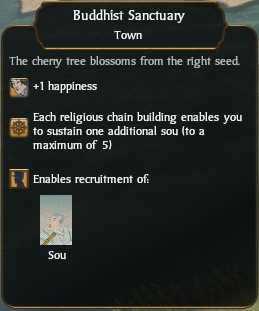

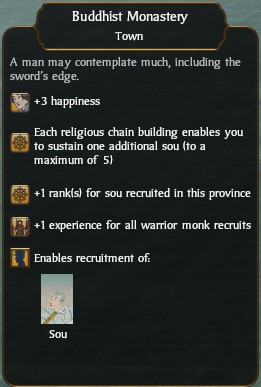
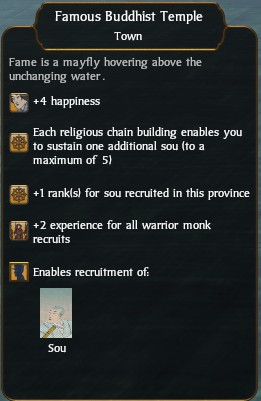
Cost: 765/1440/3360/5850
The Temple building chain allows the recruitment of the Sou agent (one per building chain up to a maximum of 5) as well as increasing the happiness of the province. They are also required for the production of Warrior Monks with the Sanctuary as a prerequisite of Bow Warrior Monks. The Buddhist Temple is the second building in the temple chain and further increases the happiness of the province, as well as allowing the construction of Naginata Warrior Monks and increasing the rank of all Warrior Monks recruited in the province. The Buddhist Monastery is the third building in the Temple chain. It further increases province happiness and increases the rank of Sou produced in this province by one. It is required for the production of the Tetsubo Warrior Monk Hero in conjunction with a Koryu Dojo. The Famous Buddhist Temple is the last building in the Temple chain. It increases province happiness even more and further increases the rank of warrior monks produced in the province. It is required for the production of Naginata Warrior Monk Heroes, in addition to a Legendary Koryju Dojo. It requires the Incense trade good.
Ingame encyclopaedia - Buddhist Sanctuary posted:
A place of refuge from the burdens of the world, a sanctuary gives the faithful a chance to understand the true meaning of the Buddha's teachings. A sanctuary can bring an air of contentment to a whole province, and train monks to spread the faith. Many Buddhist sanctuaries in Japan were built next to older Shinto shrines. In this, Japanese Buddhism was different from many other religious invasions across the world, which tended to build their new buildings on top of the wreckage of the old religion and its shrines. The new would nearly always replace the old, often with the aid of a builder's mattock. Buddhism, though, was quite content to leave a space for the kami, and even adopt some spirits as tutelary examples for the faithful. The resulting fusion of faiths lasted for hundreds of years, until the Meiji Restoration.
Ingame encyclopaedia - Buddhist Temple posted:
Construction of a temple enables the advanced training of monks. The temple itself is a place of solitude and contemplation, the perfect place to consider the world and a man's place in it. The calming influence of the temple and its adherents spreads far beyond the walls. Everyone turns to the gods in an hour of need. In the sixth century, when Prince Shotoku of the Soga needed help to banish anti-Buddhist elements from Japan, he called on the fearsome Bishamon to aid him in his efforts. Prince Shotoku's appeals were apparently answered. Originally the protector of the north, Bishamon became the protector of the law who also guarded people from illness and demons. He was a war god, and was one of the Shichi Fukujin, the seven deities of happiness and good luck. He normally appeared as a blue-faced warrior with a spear and a pagoda representing his dual personality, warrior and monk, but always a protector of the faithful.
Ingame encyclopaedia - Buddhist Monastery posted:
The construction of a monastery is a tangible commitment to Buddhism, and it increases the happiness of all people in a province. As might be expected, a monastery is a place of quiet contemplation, removed from the worries of daily life. The monks are free to reach a better understanding of Buddha and his teachings, and to hone their skills as part of their contemplative exercises. In the 8th century, Buddhist monasteries were subject to significant interference from the imperial government. Regulations controlled all aspects of monastic life, and religious leaders found themselves acting as bureaucrats rather than contemplating their own spiritual development. Driven from the monasteries to escape such interference, the monks went out into the country and took the teachings of Buddha to the population as a whole. It was not long before new monasteries, free from Imperial and Court control, were founded. It was, however, useful for the monasteries to have patronage from the great families, and to offer religious respectability in return.
Ingame encyclopaedia - Famous Buddhist Temple posted:
A great temple serves as a focus for religious devotion and a place of pilgrimage. Its monks are men of enormous faith, entirely devoted to their work. At the heart of such a temple there is often a reliquary, a focus for pilgrims. More usefully, for the temple's noble sponsors, are the training halls and scholastic facilities that produce learned and enthusiastic monks, eager to spread the word. The building style of the earliest Buddhist temples was not particularly Japanese, as they copied Chinese and Korean patterns. Over time these changed to become more distinctively Japanese to cope with the local climate, and to withstand earthquakes. There was also less distinction than might be expected between Buddhist and Shinto buildings. It was not unusual to find that Buddhist temples included Shinto shrines within them, so that the local kami would not be disturbed. Likewise, larger Shinto shrines would have Buddhist temples somewhere within the shrine complex. It was only after the Meiji Restoration in 1868 that a stricter division was introduced into Japanese religious life.
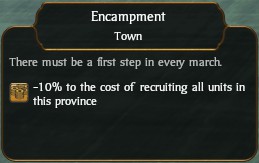
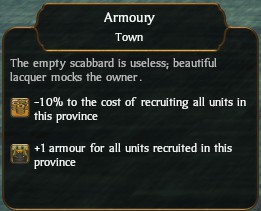
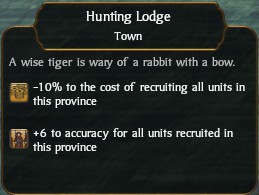
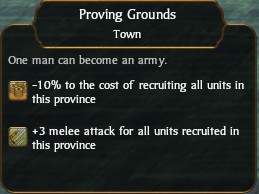
Cost: 765/1600/1600/1600
The Encampment reduces the cost of all land units recruited in this province. It can be upgraded into one of three possible buildings - Armoury, Hunting Lodge and Proving Grounds. The Armoury increases the armour of all units produced in this province. The Hunting Lodge increases the accuracy of all ranged units produced in the province. The Proving Grounds increases the melee attack of all units produced in this province.
Ingame encyclopaedia - Encampment posted:
All armies need to have somewhere for new recruits to gather and do at least a little training. An encampment can be as simple as a line of tents or have the air of a semi-permanent military town, but it has one purpose: to turn undisciplined and scared civilians into something resembling soldiers. Having one makes it easier and cheaper to recruit units, and to send casualty replacements where they are needed. Encampments have always allowed commanders to keep their men where they can be watched. Given half a chance, civilians will do their best to separate young men from their money with drink, women and gambling. All of these can cause trouble in the military, particularly as soldiers are often happy to indulge in such pleasurable alternatives to drill and training. Encampments have to be well organised, otherwise illness could sweep through them, and this gives a practical reason for learning the disciplines of a soldierly life. A man who has dug latrines for a few hundred of his comrades is likely to see battle as a pleasant alternative!
Ingame encyclopaedia - Armoury posted:
An armoury centralises the supply of arms and armour, and guarantees that all equipment will be of a given quality. It is not just a store, but usually includes workshops for craftsmen to repair and create military items. It therefore improves the defensive strength of any unit recruited in the same province. Nearly all armies of the medieval period relied on looting the dead to provide weapons and equipment for the living. Sometimes this was even an organised business. This, however, was discovered by many to be a ramshackle way to run a war. By centralising armour under the control of noble families, they could also introduce a level of uniformity into their armies. A medieval European army would be a riot of colours, liveries and heraldry, while a Japanese army would have a calm uniformity to it. This has a practical benefit for a warrior: anyone not wearing the same armour as you in a battle is almost certainly an enemy!
Ingame encyclopaedia - Hunting Lodge posted:
Hunting teaches men to fire accurately and quickly against swift-moving targets. To miss is to go hungry or be eaten by something inedible! Therefore, a hunting lodge improves the firing accuracy of missile-armed troops recruited in this province. Archery has always been about food as well as warfare. An arrow does care whether it strikes a deer or a man. Shooting and stalking skills honed in providing food always transfer to a martial context. The hunter who misses with his first shot usually never gets the chance to take a second one. Despite their poetic names, the narrow willow-leaf, willow-leaf and dragon's tongue were all lethally sharp arrow heads designed to kill the target by causing massive bleeding. Anything hit by one of these would soon bleed to death. On the other hand, archers used the blunt, turnip-shaped whistling signal arrows against their targets when dog hunting. This, presumably, allowed them to make it more of a "sport" as each dog would require several hits before it was disabled or killed.
Ingame encyclopaedia - Proving Grounds posted:
These proving grounds will improve the attacking strength of any unit trained in the province. An army is more than a collection of individuals, no matter how personally brave they may be. It needs discipline, good order and confidence in its tactics and commanders if it is to work to full effect. This includes an understanding of exactly how its weapons are best used in action. When a unit fights as one, not as a mob, using its weapons properly, its strength is magnified and fully utilised. Every soldier needs to understand and trust in the weapons he carries. This is why drill has always been an important part of training. A soldier becomes completely familiar with what he is supposed to be doing, without even the need for conscious thought. He also comes to grasp the full potential of the weapons he has been given by his commanders. Practice does pay off in combat: men trained to fight together will always be better than a mass of individuals each seeking their own petty glory.